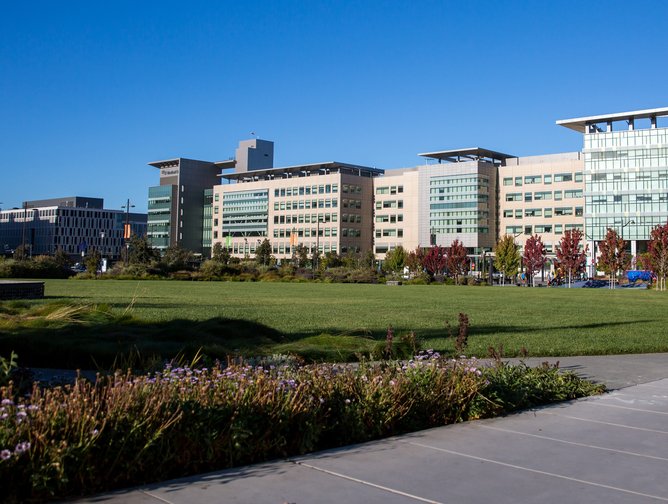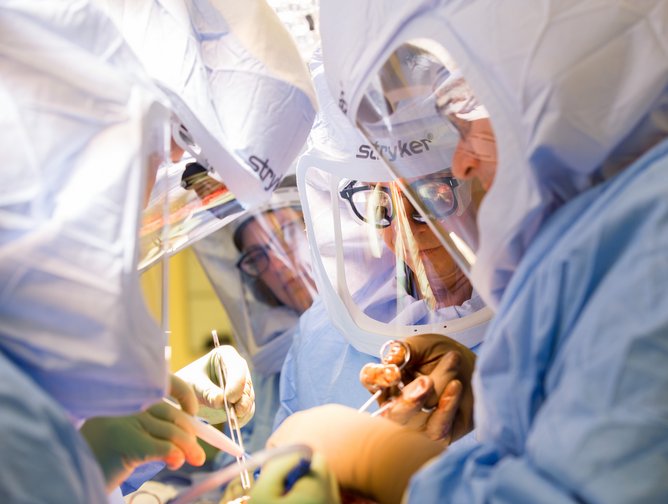Taking a look at UCSF Health’s automated, robotic-enabled supply chain
UCSF Health is at the forefront of healthcare innovation but, behind the scenes, the group’s Medical Center supply chain team are keeping the cogs turning so it can focus on delivering the state-of-the-art care it is known for.
UCSF Medical Center was recently named among the nation’s premier medical institutions for the 17th consecutive year, standing as the fifth best hospital in the country and the top-ranked hospital in California, according to U.S. News & World Report’s 2017-2018 Best Hospitals survey.
In the back-end, its supply chain team is responsible for a comprehensive set of services that continually strengthen the scope of its patient care. The organisation provides access to a broad range of medical-surgical products, and consistently seeks to reduce supply chain waste and expenses but, above all else, it is committed to delivering quality customer service, which enables premium care.
When he began as a buyer in procurement almost 16 years ago, Jake Limbert, now Director of Supply Chain Operations, did many menial and repetitive tasks – that’s when he realized how transformative technology could be.
“I found myself doing the same set of rote and rudimentary tasks every day,” he notes. “I began to realize that with the help of our Materials Management Information Systems Team (MMIS Team) we could automate a lot of the procurement activity I was encountering.”
Automation has become a prevalent trend in the supply chain field and it hasn’t gone amiss at UCSF Health. In 2009, Limbert and his team partnered with Global Healthcare Exchange (GHX) to develop tools that allowed his team to onboard vendors who would then receive their purchase orders (POs) in a highly-automated and accurate fashion.
“A requester at the hospital could scan an order or put through a request and that would queue up a requisition that would be turned into a purchase order automatically without any buyer intervention,” explains Limbert. “We call it ‘no touch POs.’
“We were able to do that on a fairly large scale. We have about 600 POs that go out every day and so we were really able to take our PO activity and just turn it into an automated process. At that point, we could also hard code shipping and logistical standards with all of our vendors so they knew that UCSF had an exact and predictable timeframe to deal with.”
Building on this partnership, GHX then built Registration Center, otherwise known as ‘RegCenter’ which allowed UCSF Health to onboard its own vendors. As a result of its efforts, UCSF was later recognized by GHX in 2011 with their first every Industry Impact Award.
Since then, Limbert and his team have continued on an upward trajectory thanks to new and improved technological innovations. In 2015, the UCSF Medical Center at Mission Bay opened, aiming to set new standards for healthcare in the 21st century.
The 289-bed complex features three separate hospitals, specialized in serving children, women and cancer patients. With such a mammoth operation, Limbert and his team wanted to focus on automation and streamlining operations where possible.
With the latest wave of innovation, it seems robotics are redrawing the healthcare landscape. Keen to tap into this emerging trend, UCSF Health teamed up with Aethon to use its autonomous mobile TUG robots. These new-generation robots allow UCSF Health to distribute items easily and reallocate their workforce so team members can focus on value-adding tasks rather than repetitive jobs.
“This was revelatory as it allowed us to reallocate our full-time equivalent (FTE) resources,” said Limbert. “We also utilize the TUGS for our soiled linen pickup which helped us reduce employee injuries because, given census and patient volumes, these linen carts are becoming increasingly unwieldy. Thanks to robotics we've been able to keep our employees in an area where they're most effective and appreciated. They’re able to further support clinicians.”
Like many in the supply chain discipline, UCSF Health has worked to streamline and standardize its processes, so that the medical professionals can focus on what matters — patient care. Every patient’s healthcare needs are unique and highly personalized.
Therefore, Limbert and his team worked closely with clinicians to establish their needs and maintain the unparalleled, innovative care UCSF is known for. In doing so, the group has worked to strike a balance between streamlined, cost-effective supply chain processes whilst meeting the individualistic needs of the clinicians and patients alike.
“If they're able to interact with clinicians in a meaningful way then that allows us to again, gain their trust,” explains Limbert. “We just don't want people stocking shelves, we want people to engage the clinician and figure out their needs so we can make sure they are enabled to deliver the highest quality of care.”
See also:
- The Medical City: Driving positive patient outcomes through digitisation
- How Emitac Healthcare Solutions is delivering top-class healthcare technology in the Middle East
- UCSF Health’s Precision Cancer Medicine Building and its cutting-edge facilities management
“There's a certain level of expectation that our clinicians demand and I think we are able to provide that by empowering our employees to resource and make decisions on their own. We call them our ‘supply chain ambassadors.’ We want them to be resources for the customers, not just inventory technicians.
“The real product for us is patient care. Every patient has a different set of needs and a clinical path unique to them.
“We are able to engage the end user, the clinician, and say, ‘These are our schematics and this is our framework. Does this synch with your needs?’ Almost like a switchboard, we plug and slot them into our order of business.
“Alternatively, they might say, ‘Well that's not really going to work because our cases start at 7:00 a.m. so we need product replenished by 5:00am,’ for example. In that case, we are able to scale it and tweak it for them.
“That is a challenge, however, it's also something that we relish. Every patient is unique and they are our number one priority. I think we have to be mindful of where we can standardize and where we can't.”
The opening of the UCSF Benioff Children’s Hospital at Mission Bay was not only a key milestone in the institutions’ history, but it also gave Limbert and his team a fresh slate to drive efficiencies and cost savings. In doing so, the team had two focuses: the first was the customer and the second was generating operational data.
“First, we determined, having learned from previous successes and failures, what the customer expected from us and what they needed in order to deliver the quality care that our patients deserve,” explains Limbert. “We were able to listen and figure out what worked and didn't in the previous care area and then adapt and create new workflows, meaningful periodic automatic replenishment (PAR) levels and service level agreements (SLAs).
“Secondly, we built a very robust and intricate set of data,” he continues. “In order to achieve the previously established automation, we had to engage MMIS and our vendors to ensure the efficiencies would be mirrored in another facility.
“We devised new shipping locations and schedules aligned with our new docks for optimal transport up to the unit. For example, right now a technician will transmit an order and in less than 12 minutes the vendor will have it. They can pick it and then it will show up the next day at that room in fewer than 24 hours.”
With 78mn products delivered annually at UCSF, its supply chain operation is mammoth in scale. Now, as the organization expands, Limbert says the biggest challenge is sustaining this growth.
“It's a good problem to have in that the healthcare environment in the Bay Area is very competitive but if we can empower our clinicians to provide better care then we can also grow with them in a way that's meaningful,” notes Limbert.
“Allowing our ambassadors and staff to feel ownership over the care that we're providing is vital. If you can illuminate their piece within this dynamic jigsaw, it helps them feel more engaged and proud to provide a crucial piece in the patient care continuum.”







